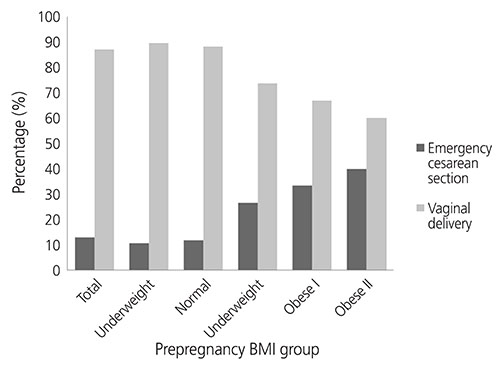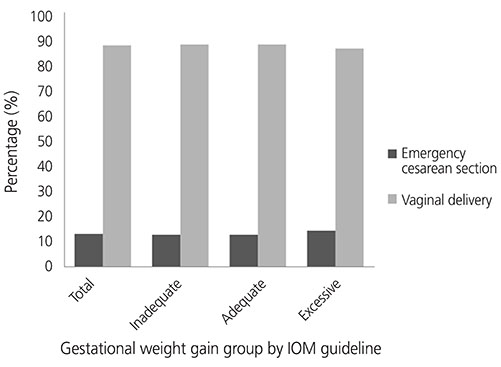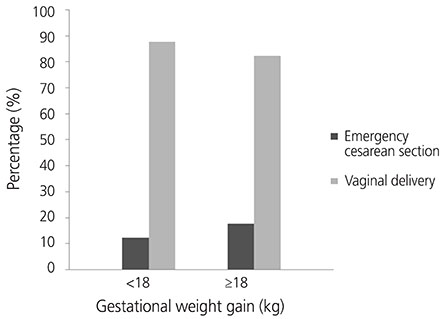Obstet Gynecol Sci.
2016 May;59(3):169-177. 10.5468/ogs.2016.59.3.169.
The risk of emergency cesarean section after failure of vaginal delivery according to prepregnancy body mass index or gestational weight gain by the 2009 Institute of Medicine guidelines
- Affiliations
-
- 1Department of Obstetrics and Gynecology, Dongguk University Ilsan Hospital, Goyang, Korea.
- 2Institute of Women's Life Medical Science, Yonsei University College of Medicine, Seoul, Korea. yhkim522@yuhs.ac
- 3Division of Maternal-Fetal Medicine, Department of Obstetrics and Gynecology, Severance Hospital, Yonsei University College of Medicine, Seoul, Korea.
- KMID: 2351781
- DOI: http://doi.org/10.5468/ogs.2016.59.3.169
Abstract
OBJECTIVE
To evaluate the risk of emergency cesarean section according to the prepregnancy body mass index (BMI) and gestational weight gain per the 2009 Institute of Medicine guidelines.
METHODS
A retrospective analysis of data from 2,765 women with singleton full-term births (2009 to 2012) who attempted a vaginal delivery was conducted. Pregnancies with preeclampsia, chronic hypertension, diabetes, planned cesarean section, placenta previa, or cesarean section due to fetal anomalies or intrauterine growth restriction were excluded. Odds ratios (ORs) and confidence intervals (CIs) for emergency cesarean section were calculated after adjusting for prepregnancy BMI or gestational weight gain.
RESULTS
Three-hundred and fifty nine (13.0%) women underwent emergency cesarean section. The adjusted OR for overweight, obese, and extremely obese women indicated a significantly increased risk of cesarean delivery. Gestational weight gain by Institute of Medicine guidelines was not associated with an increased risk of cesarean delivery. However, inadequate and excessive weight gain in obese women was highly associated with an increased risk of emergency cesarean section, compared to these in normal BMI (OR, 5.56; 95% CI, 1.36 to 22.72; OR, 3.63; 95% CI, 1.05 to 12.54; respectively), while there was no significant difference between normal BMI and obese women with adequate weight gain.
CONCLUSION
Obese women should be provided special advice before and during pregnancy for controlling weight and careful consideration should be needed at the time of vaginal delivery to avoid emergency cesarean section.
Keyword
MeSH Terms
Figure
Reference
-
1. Villamor E, Cnattingius S. Interpregnancy weight change and risk of adverse pregnancy outcomes: a population-based study. Lancet. 2006; 368:1164–1170.2. Korea Centers for Disease Control and Prevention. Korea National Health and Nutrition Examination Survey 2012. Cheongju: Korea Centers for Disease Control and Prevention;2013.3. Graham LE, Brunner Huber LR, Thompson ME, Ersek JL. Does amount of weight gain during pregnancy modify the association between obesity and cesarean section delivery? Birth. 2014; 41:93–99.4. Burrows LJ, Meyn LA, Weber AM. Maternal morbidity associated with vaginal versus cesarean delivery. Obstet Gynecol. 2004; 103(5 Pt 1):907–912.5. Jespersen C, Hegaard HK, Schroll AM, Rosthoj S, Kjaergaard H. Fear of childbirth and emergency caesarean section in low-risk nulliparous women: a prospective cohort study. J Psychosom Obstet Gynaecol. 2014; 35:109–115.6. Young TK, Woodmansee B. Factors that are associated with cesarean delivery in a large private practice: the importance of prepregnancy body mass index and weight gain. Am J Obstet Gynecol. 2002; 187:312–318.7. Obesity: preventing and managing the global epidemic. Report of a WHO consultation. World Health Organ Tech Rep Ser. 2000; 894:i–xii. 1–253.8. Rasmussen KM, Catalano PM, Yaktine AL. New guidelines for weight gain during pregnancy: what obstetrician/gynecologists should know. Curr Opin Obstet Gynecol. 2009; 21:521–526.9. Hong JS, Yi SW, Han YJ, Park YW, Nam CM, Kang HC, et al. Fetal growth and neonatal mortality in Korea. Paediatr Perinat Epidemiol. 2007; 21:397–410.10. Crane SS, Wojtowycz MA, Dye TD, Aubry RH, Artal R. Association between pre-pregnancy obesity and the risk of cesarean delivery. Obstet Gynecol. 1997; 89:213–216.11. Kerrigan AM, Kingdon C. Maternal obesity and pregnancy: a retrospective study. Midwifery. 2010; 26:138–146.12. Wolfe KB, Rossi RA, Warshak CR. The effect of maternal obesity on the rate of failed induction of labor. Am J Obstet Gynecol. 2011; 205:128.e1–128.e7.13. Morken NH, Klungsoyr K, Magnus P, Skjaerven R. Pre-pregnant body mass index, gestational weight gain and the risk of operative delivery. Acta Obstet Gynecol Scand. 2013; 92:809–815.14. Jensen H, Agger AO, Rasmussen KL. The influence of prepregnancy body mass index on labor complications. Acta Obstet Gynecol Scand. 1999; 78:799–802.15. Tanaka T, Ashihara K, Nakamura M, Kanda T, Fujita D, Yamashita Y, et al. Associations between the pre-pregnancy body mass index and gestational weight gain with pregnancy outcomes in Japanese women. J Obstet Gynaecol Res. 2014; 40:1296–1303.16. Jang DG, Jo YS, Lee GS. Effect of pre-pregnancy body mass index and weight gain during pregnancy on the risk of emergency cesarean section in nullipara. Arch Gynecol Obstet. 2011; 284:1389–1397.17. Li C, Liu Y, Zhang W. Joint and independent associations of gestational weight gain and pre-pregnancy body mass index with outcomes of pregnancy in chinese women: a retrospective cohort study. PLoS One. 2015; 10:e0136850.18. Krishnamoorthy U, Schram CM, Hill SR. Maternal obesity in pregnancy: is it time for meaningful research to inform preventive and management strategies? BJOG. 2006; 113:1134–1140.19. O'Dwyer V, Farah N, Fattah C, O'Connor N, Kennelly MM, Turner MJ. The risk of caesarean section in obese women analysed by parity. Eur J Obstet Gynecol Reprod Biol. 2011; 158:28–32.20. Kristensen J, Vestergaard M, Wisborg K, Kesmodel U, Secher NJ. Pre-pregnancy weight and the risk of stillbirth and neonatal death. BJOG. 2005; 112:403–408.21. Johnson J, Clifton RG, Roberts JM, Myatt L, Hauth JC, Spong CY, et al. Pregnancy outcomes with weight gain above or below the 2009 Institute of Medicine guidelines. Obstet Gynecol. 2013; 121:969–975.
- Full Text Links
- Actions
-
Cited
- CITED
-
- Close
- Share
- Similar articles
-
- Perinatal outcomes associated with prepregnancy body mass index and weight gain during pregnancy
- Association of cesarean delivery with increases in maternal body mass index
- An association of gestational weight gain and prepregnancy body mass index with perinatal outcomes
- The Association of Maternal Body Mass Index with Birth Weight and Cesarean Delivery
- The Effect of Prepregnancy Body Mass Index and Weight Gain during Pregnancy on Infant Birth Weight




